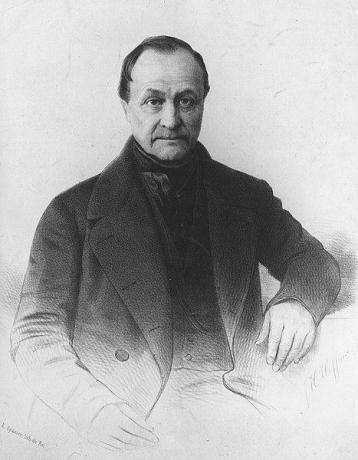The syllogism is the basic structure of an argument or deductive reasoning, which is formed by three propositions that are interconnected.
In philosophy, the syllogism is an integral part of Aristotelian logic and is based on deduction. That is, it starts from true statements to a new statement that is also true.
Aristotle (384 a. C.-322 a. C.) used this method in studies of logical argumentation.
The syllogism theory was presented by him in his work "Analytic Priora” (Previous Analytics).
Did you know?
From the Greek, the term syllogism (syllogisms) means “conclusion” or “inference”.
Examples of Syllogism
Example 1:
Every man is mortal.
Socrates is a man.
Socrates is mortal.
Example 2:
Every Brazilian is South American.
Every northeaster is Brazilian.
Therefore, every northeaster is South American.
Example 3:
Every politician is a liar.
Joseph is a politician.
Therefore, Joseph is a liar.
Composition of the Aristotelian Syllogism
The first and second propositions are called premises and the last is the conclusion:
- Major Assumption (P1): declaratory, whence all M é P.
- Minor Premise (P2): indicative, whence s é M.
- Conclusion: the union of the first two premises, it is possible to deduce the third proposition, from which s é P.
See too: What is logic?
Syllogism Terms
The syllogism consists of three terms:
- Longer Term: also called the major extreme, it appears in the major premise, being the predicate term of the conclusion. It is represented by P.
- Minor Term: also called the minor extreme, it appears in the minor premise, being the subject term of the conclusion. It is represented by s.
- Medium Term: it appears in both premises, however, it does not appear in the conclusion. It is represented by M.
False Syllogism
THE fallacy it is considered a “false syllogism” since it is invalid in the construction of categorical syllogisms.
Therefore, the fallacy is a misleading argument, a wrong idea or a false belief.
Example:
All swans are not black.
Some birds are swans.
Soon, all birds are not black.
For the above propositions to be considered a syllogism, the conclusion should be: Some birds are not black.
This is because the conclusion of the syllogism always follows the negative or particular premise, and in this case, “some”.
Rules for Syllogism Construction
We must take into account that there are some rules for the construction of the categorical syllogism, that is, so that they are valid and do not fall into the fallacy problem.
In relation to syllogism terms we have:
1.A syllogism has three terms (major, minor and medium) and must have the same meaning throughout the reasoning:
all Lion is a mammal.
some people are from Lion.
So some people are mammals.
In this case, the term “lion” was used in two senses: the animal and the sign. This syllogism is not valid because it contains four terms: lion (animal); lion (sign); mammals and people.
2. The middle term must never appear at the conclusion of the syllogism. The function of the middle term is to link the two premises.
None canid it's feline.
all canid it is carnivorous.
So this canid it is not a feline carnivore.
So the above example is not a syllogism but a formal fallacy.
The major and minor term and must be taken, at least once, in its entirety.
All fruits are vegetable.
All vegetables are vegetable.
Therefore, all vegetables are fruits.
In this case of formal fallacy, we have that vegetables (such as fruits or vegetables) are a part of the total range of vegetables.
4. At the conclusion of the syllogism, the terms major and minor cannot appear to a greater extent than in the premises:
Every violent act is reprehensible.
many human beings commit violent acts.
Soon, all human beings are reprehensible.
In that case, the conclusion of the syllogism should be: Many human beings are reprehensible.
In relation to syllogism propositions, we have:
5. When a syllogism has two affirmative premises, the conclusion must also be affirmative:
All felines are mammals.
All mammals are vertebrates.
Soon, some vertebrates they are not cats.
In this example, the conclusion of the syllogism should be: Some vertebrates are felines.
6. When a syllogism has two negative premises, nothing can be concluded:
None mother is insensitive.
Some women they are not mothers.
Therefore, some women are insensitive.
In this case of formal fallacy, there is an unjustified conclusion and therefore it is not a syllogism.
7. When a syllogism has two particular premises, it is not possible to conclude anything:
Some sellers are not honest.
Some Brazilians are sellers.
Therefore, some Brazilians are not honest.
We have above an example that violates the syllogism rule, based on an inconclusive proof.
8. The conclusion of a syllogism will always follow the weaker part, that is, the negative and/or particular premise:
All cats are not white.
Some felines are cats.
Soon, all cats are not white.
In the example above, the conclusion of the syllogism should be: Some cats are not white.
Types of Syllogism
According to the Aristotelian Syllogism, there are two types of syllogism:
- Dialectical Syllogism: based on hypothetical or uncertain judgments. In this case, the syllogism is used in studies of rhetoric and persuasion and refers to opinions.
- Scientific Syllogism: based on scientific arguments, which contain the truth value both in the premises and in the conclusions.
Legal Syllogism
In the area of law, the syllogism is used as a tool to conclude facts. This type of syllogism is classified into:
- Presentation of the major premise
- Presentation of facts
- Conclusion by legislation
Example of legal syllogism:
Killing someone is a crime and the murderer must be punished.
Joan killed someone.
Therefore, Joan must be punished.
See more:
- Aristotle
- Aristotelian Logic
- Deductive Method
- Inductive Method
- Sophistry
- Mathematical logic
- Truth table

